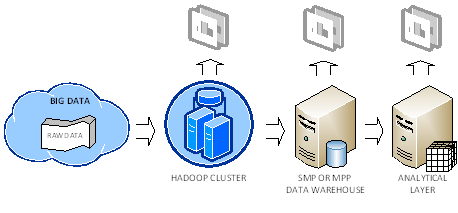MS BI Guy Does Hadoop (Part 5 – The Big Picture)
Let’s recap my thoughts on Hadoop. I’ve found the case studies presented in the chapter 16 of the “Hadoop: The Definitive Guide” book very useful to understand how organizations are currently using Hadoop. In general, the following deployment scenario emerges as a common pattern:

- An organization accumulates Big Data from various sources, such as web logs, sensors, website traffic, and so on. The organization decides to store the raw data in the Hadoop fault-tolerant file system (HDFS). As far as cost, RainStor published an interesting study about the cost of running Hadoop. It estimated that you need an investment of $375 K to store 300 TB which translates to about $1,250 per terabyte before compression. I reached about the same conclusion from the price of single PowerEdge C2100 database server, which Dell recommends for Hadoop deployments.
Note I favor the term “raw data” as opposed to unstructured data. In my opinion, whatever Big Data is accumulated, it has some sort of structure. Otherwise, you won’t be able to make any sense of it. A flat file is no less unstructured than if you use it as a source for ETL processes but we don’t call it unstructured data. Another term that describes the way Hadoop is typically used is “data first” as opposed to “schema first” approach that most database developers are familiar with.
- Saving Big Data in a Hadoop cluster not only provides a highly-available storage but it also allows the organization to perform some crude BI on top of the data, such as by analyzing data in Excel by using the Hive ODBC driver, which I discussed in my previous blog.
- The organization might conclude that the crude BI results are valuable and might decide to add them (more than likely by pre-aggregating them first to reduce size) to its data warehouse running on an SMP server or MPP system, such as Parallel Data Warehouse. This will allow the organization to join these results to conformant dimensions to support analyzing data by other subject areas then the ones included in the raw data. The important point here is that Hadoop and RDBMS are not competing but completing technologies.
- Ideally, the organization would add an analytical layer, such as an Analysis Services OLAP cube, on top of the data warehouse. This is the architecture that Yahoo! and Klout followed. See my Why an Analytical Layer? blog about the advantages of having an analytical layer.
Note Currently, it’s not possible for an Analysis Services OLAP cube to load data directly from Hadoop because of the subselect queries that the ODBC cartridge injects. PowerPivot or Tabular would work as they use opaque queries (QueryDefinition query bindings).
The world has spoken and Hadoop will become an increasingly important platform for storing Big Data and distributed processing. And, all the database mega vendors are pledging their support for Hadoop. On the Microsoft side of things, here are the two major deliverables I expect from the forthcoming Microsoft Hadoop-based Services for Windows whose community technology preview (CTP) is expected by the end of the year:
- A supported way to run Hadoop on Windows. Currently, Windows users have to use Cygwin and Hadoop is not supported for production use on Windows. Yet, most organizations run Windows on their servers.
- Ability to code MapReduce jobs in .NET programming languages, as opposed to using Java only. This will significantly broaden the Hadoop reach to pretty much all developers.




